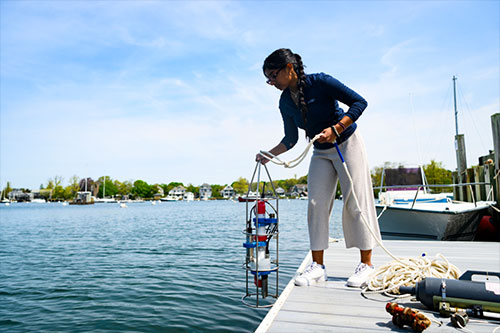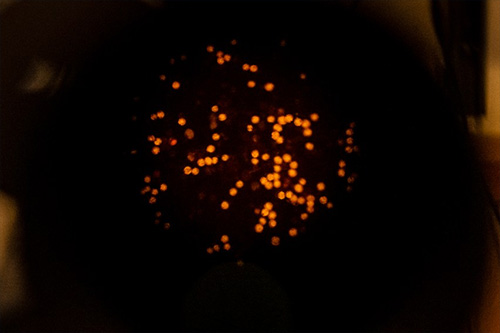Co-op student Anushka Rajagopalan at the dock by the Woods Hole Oceanographic Institution on Cape Cod, where she is studying Alaskan algae blooms that cause paralytic shellfish poisoning. The blooms threaten the shellfish industry as well as the lives of birds, fish, marine mammals, pets foraging on the beach - and even humans. |
In particular, Rajagopalan is focused on Alexandrium catenella, a single-celled marine plankton that produces the neurotoxins that cause paralytic shellfish poisoning.
"It's impacted the Alaskan coastal community pretty severely," says Rajagopalan, whose six-month co-op ends June 30.
"A lot of restaurants have had to close down and a lot of fish markets haven't been able to collect shellfish from affected areas for several years now," she says.
"Indigenous communities are particularly impacted by it because shellfish and fish are main sources of subsistence," Rajagopalan says.
Poisoning occurs after shellfish ingest the neurotoxin created by algal blooms.
"The shellfish themselves don't get poisoned. But other marine animals, like seals, who eat shellfish have been having higher mortality rates because of this poisoning," Rajagopalan says.
The poisonings also affect other marine animals, birds, fish, pets foraging on beaches and even humans.
The Washington state Department of Health says deaths have occurred 30 minutes after ingesting poisoned shellfish, with fatalities attributed to suffocation as chest muscles become paralyzed. There is no antidote to the poisoning, only life support for severe cases.
"Research that is done in this lab will be helpful for future mitigation strategies and long term monitoring for coastal communities," says Rajagopalan, a third-year student majoring in ecology and evolutionary biology.
The co-op student says she is finalizing analysis of water and sediment samples containing Alexandrium cells collected by a WHOI research vessel from a stretch of sea from western Alaska to the eastern border of Russia.
Anushka Rajagopalan analyzes tubes of water and sediment collected by Woods Hole Oceanographic Institution researchers in Alaska and examines the cells of the toxic Alexandrium catenella algae under a microscope using fluorescent probes for her co-op in Woods Hole. |
Each tube of water comes with information about the temperature, salinity, nutrient content and other environmental factors in its collection area, Rajagopalan says.
She examines the Alexandrium cells under a microscope using fluorescent probes, a protocol known as the FISH method for Fluorescence in Situ Hybridization.
"They collected samples not only at the surface of the water but at various depths throughout the water," Rajagopalan says.
"We're wondering whether these Alexandrium blooms differ based on water depth and how that could relate to other environmental factors such as physical oceanographical and biogeochemical factors."
A 2021 report from the National Oceanic and Atmospheric Administration Fisheries says that algal blooms were once rare in Alaska but are increasing, which scientists from NOAA and WHOI say is due in at least part to warming seas.
The Anderson lab at WHOI hopes to publish the results of the research she is working on by next year, says Rajagopalan, who plans to finish up her undergraduate degree at Northeastern by 2024.
She says she intends to pursue a Ph.D. in fields relating to biodiversity and conservation biology, perhaps coral biology—which she studied in her first co-op last year at the Smithsonian Tropical Research Institute in Panama.
In the meantime, Rajagopalan is counting on research being done at Anderson's WHOI lab to make a difference when it comes to combating the effects of algal blooms.
"There are whole communities around the world that are relying on this research and information," she says.
"Awareness about these projects will hopefully bring more support and funding for long-term monitoring. We are collaborating with universities in Alaska and international universities to bring in more support and aid."
This article is provided by Northeastern University. Northeastern University is located in Boston, Arlington, Burlington, Charlotte, London, Miami, Nahant, Oakland, Portland, Seattle, Silicon Valley, Toronto, Vancouver. Cynthia McCormick Hibbert is a writer for the Northeaster University's Northerneastern Global News. |
Representations of fact and opinions in comments posted are solely those of the individual posters and do not represent the opinions of Sitnews.
Send a letter to the editor@sitnews.us
SitNews ©2023
Stories In The News
Ketchikan, Alaska
Articles & photographs that appear in SitNews are considered protected by copyright and may not be reprinted without written permission from and payment of any required fees to the proper freelance writers and subscription services.
E-mail your news & photos to editor@sitnews.us
Photographers choosing to submit photographs for publication to SitNews are in doing so granting their permission for publication and for archiving. SitNews does not sell photographs. All requests for purchasing a photograph will be emailed to the photographer.


